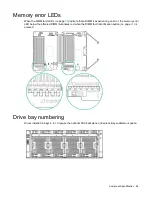
Diagnostic tools 78
USB support
Hewlett Packard Enterprise servers support both USB 2.0 ports and USB 3.0 ports. Both types of ports
support installing all types of USB devices (USB 1.0, USB 2.0, and USB 3.0), but may run at lower speeds
in specific situations:
•
USB 3.0 capable devices operate at USB 2.0 speeds when installed in a USB 2.0 port.
•
When the server is configured for UEFI Boot Mode, Hewlett Packard Enterprise provides legacy
USB support in the pre-boot environment prior to the operating system loading for USB 1.0, USB 2.0,
and USB 3.0 speeds.
•
When the server is configured for Legacy BIOS Boot Mode, Hewlett Packard Enterprise provides
legacy USB support in the pre-boot environment prior to the operating system loading for USB 1.0
and USB 2.0 speeds. While USB 3.0 ports can be used with all devices in Legacy BIOS Boot Mode,
they are not available at USB 3.0 speeds in the pre-boot environment. Standard USB support (USB
support from within the operating system) is provided by the OS through the appropriate USB device
drivers. Support for USB 3.0 varies by operating system.
For maximum compatibility of USB 3.0 devices with all operating systems, Hewlett Packard Enterprise
provides a configuration setting for USB 3.0 Mode. Auto is the default setting. This setting impacts USB
3.0 devices when connected to USB 3.0 ports in the following manner:
•
Auto (default)
—If configured in Auto Mode, USB 3.0 capable devices operate at USB 2.0 speeds in
the pre-boot environment and during boot. When a USB 3.0 capable OS USB driver loads, USB 3.0
devices transition to USB 3.0 speeds. This mode provides compatibility with operating systems that
do not support USB 3.0 while still allowing USB 3.0 devices to operate at USB 3.0 speeds with
state-of-the art operating systems.
•
Enabled
—If Enabled, USB 3.0 capable devices operate at USB 3.0 speeds at all times (including
the pre-boot environment) when in UEFI Boot Mode. This mode should not be used with operating
systems that do not support USB 3.0. If operating in Legacy Boot BIOS Mode, the USB 3.0 ports
cannot function in the pre-boot environment and are not bootable.
•
Disabled
—If configured for Disabled, USB 3.0 capable devices function at USB 2.0 speeds at all
times.
The pre-OS behavior of the USB ports is configurable in the UEFI System Utilities, so that the user can
change the default operation of the USB ports. For more information, see the
HPE UEFI System Utilities
User Guide for HPE ProLiant Gen9 Servers
on the Hewlett Packard Enterprise website
http://www.hpe.com/info/uefi/docs
External USB functionality
Hewlett Packard Enterprise provides external USB support to enable local connection of USB devices for
server administration, configuration, and diagnostic procedures.
For additional security, external USB functionality can be disabled through USB options in UEFI System
Utilities.
Internal USB functionality
An internal USB connector is available for use with security key devices and USB drive keys. This solution
provides for use of a permanent USB key installed in the internal connector, avoiding issues of clearance
on the front of the rack and physical access to secure data.
Summary of Contents for ProLiant DL580 Gen9
Page 5: ...Contents 5 Documentation feedback 106 Index 107 ...
Page 13: ...Customer self repair 13 ...
Page 14: ...Customer self repair 14 ...
Page 15: ...Customer self repair 15 ...
Page 98: ...Cabling 98 Front video USB cabling Power supply data cabling ...
Page 99: ...Cabling 99 Standby power cabling Systems Insight Display cabling ...
















































